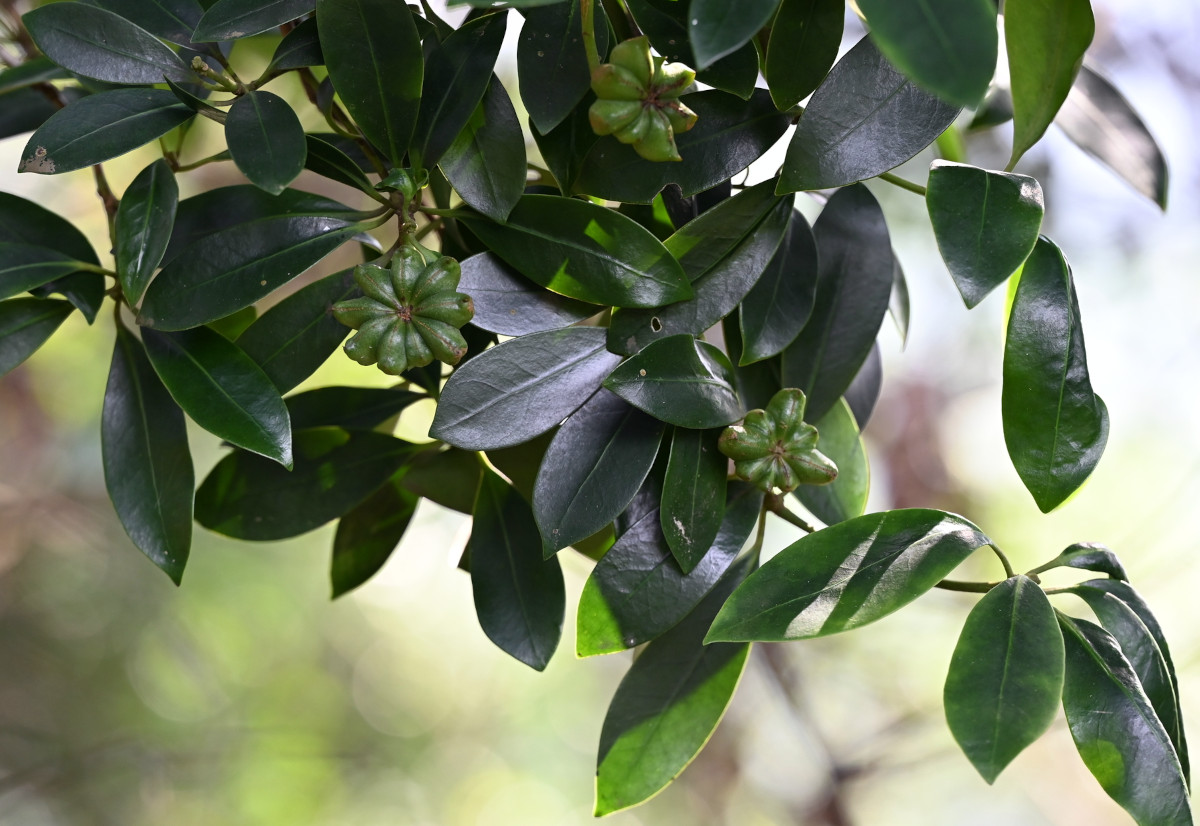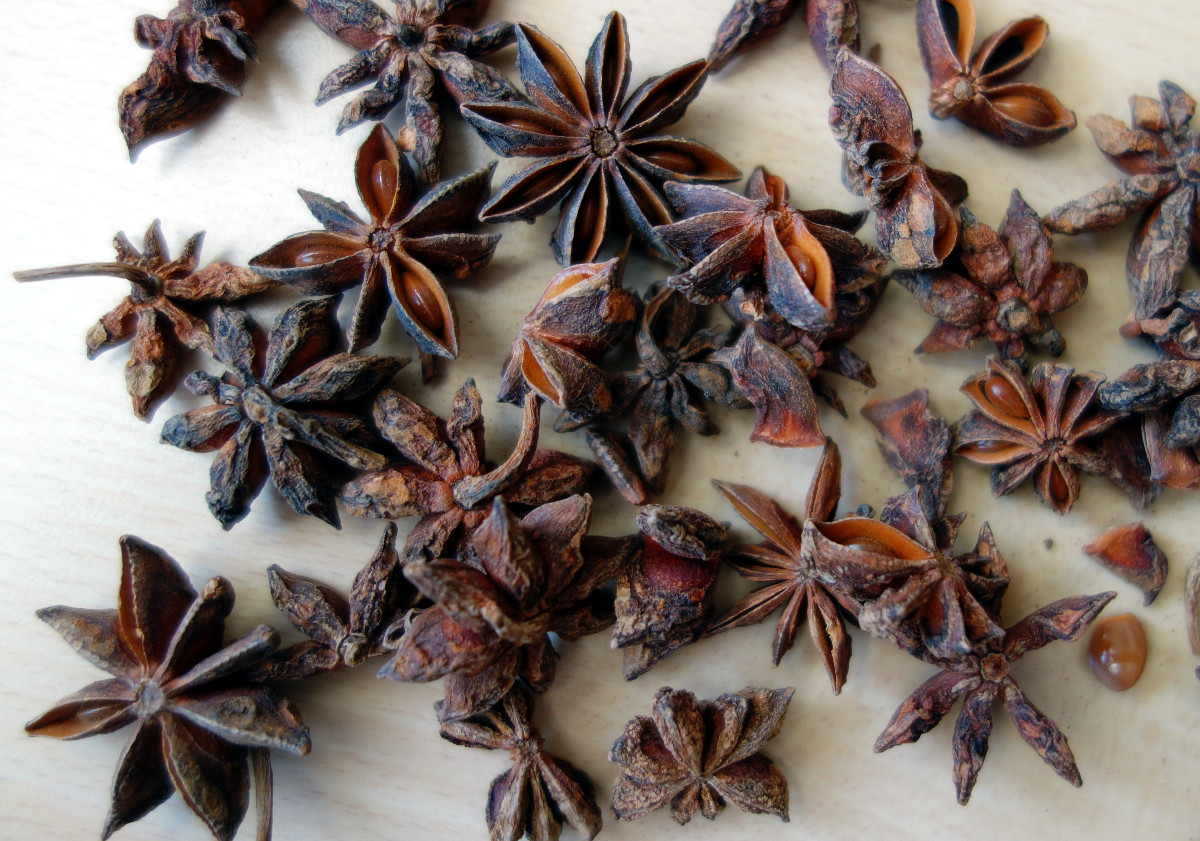Illicium verum Hook. - Schisandraceae - 八角 ba jiao (chin.), star anise, Chinese Anise, Sternanis
Evergreen tree, up to 15m tall; leaves simple, ovate, attenuate, leathery to thickly leathery; flowers pink to dark red; fruit with ca. 8 follicles. „This species is cultivated for perfume, medicines, and as a culinary spice in Fujian, Guangdong, Guangxi, Jiangxi, and Yunnan, as well as in Vietnam. It is uncertain if the plants in Guangxi are wild or naturalized and from where the species truly originates.“
http://www.efloras.org/florataxon.aspx?flora_id=3&taxon_id=200008460
From the volatile oil extracted from I.verum by steam distillation, 41 compounds were identified by GC/MS. Main components were (E)-anethole (74.1%), p-allylanisole (methyl chavicol, estragol, 4.7%), p-allylphenol (chavicol, 3.7%), (Z)-anethole (2.0%), anisaldehyde (1.7%), and cuminaldehyde (1.6%).
[Component analysis of volatile oil from Illicium Verum Hook. f., Yan, J. H., Xiao, X. X., Huang, K. L., Journal of Central South University of Technology, Vol.9(3), 2002, 173-176]
„GC and GC-MS analysis of fruit volatile oil of star anise (Illicium verum Hook) showed the presence of 25 components which account for the 99.9% of the total amount. The major components were trans-anethole (94.37%), methyl chavicol (1.82%) and cis-anethole (1.59%). 15 Components were identified from its acetone extract accounting for 80.27% of the total amount. trans-Anethole (51.81%) was found as a major component along with linoleic acid (11.6%), 1-(4-methoxyphenyl)-propan-2-one (6.71%), foeniculin (5.29%) and palmitic acid (1.47%). Using an inverted petriplate method, the volatile oil completely inhibited the growth of Fusarium moniliforme at 6 µl dose. In case of extract, 50% mycelial zone inhibition was obtained for Penicillium citrinum and Penicillium viridicatum. Moreover, using food poison technique, the volatile oil was found to be effective for controlling the growth of F. moniliforme and Aspergillus niger whereas the extract has been found to be highly effective for Aspergillus flavus. In antibacterial investigations, using agar well diffusion method, the extract has shown better activity for Staphylococcus aureus and Bacillus cereus in comparison with volatile oil and commercial bactericide, ie Ampicillin. However, volatile oil has shown better activity for Salmonella aeruginosa and Bacillus subtilis. Moreover, the extract has shown excellent activity for the inhibition of primary and secondary oxidation products in rapeseed oil which were evaluated using peroxide, thiobarbituric acid, p-anisidine and carbonyl values. The activity of extract was further confirmed using other antioxidant properties such as ferric thiocyanate method in linoleic acid system, reducing power and scavenging effect (%) on 1,1-diphenyl-2-picrylhydrazyl radical (DPPH) radical. Hence, the extract could be considered as natural antioxidant which may be used for chemoprevention of diseases occurring due to oxidative deterioration.“
[Chemical constituents, antimicrobial investigations and antioxidative potential of volatile oil and acetone extract of star anise fruits., Singh, G., Maurya, S., Delampasona, M. P., Catalan, C., Journal of the Science of Food and Agriculture, vol.86(1), 2006, 111-121]
Using hydrodistillation-headspace solvent microextraction (HD-HSME) and GC-MS, 49 compounds were separated from star anise. Volatiles mainly included (E)-anethole (81.4%), limonene (6.5%), chavicol (2.1%), and anisaldehyde (1.8%).
[Determination of essential oil components of star anise (Illicium verum) using simultaneous hydrodistillation–static headspace liquid-phase microextraction–gas chromatography mass spectrometry., Gholivand, M. B., Rahimi-Nasrabadi, M., Chalabi, H., Analytical Letters, Vol.42(10), 2009, 1382-1397]
„The volatile compounds from the pericarps of Illicium anisatum L., Illicium brevistylum A.C.Sm., Illicium griffithii Hook.f. & Thomson, Illicium henryi Diels, Illicium lanceolatum A.C.Sm., Illicium majus Hook.f. & Thomson, Illicium micranthum Dunn, and Illicium verum Hook.f. were examined by thermal desorption-gas chromatography-mass spectrometry (TD-GC-MS). The volatiles desorbed from the pericarps of I. verum (Chinese star anise), the species traded for culinary purposes, were generally characterized by a high proportion of (E)-anethole (57.6-77.1%) and the presence of foeniculin; the latter was otherwise only detected in the pericarps of I. lanceolatum. In the pericarps of all other species analyzed, the percentage composition of (E)-anethole was comparatively lower (<or=16.0%). The volatiles desorbed from the pericarps of the toxic I. anisatum (Japanese star anise) were characterized by the presence of asaricin, methoxyeugenol, and two other eugenol derivatives, none of which were detected in any of the other species examined.“
[Howes, Melanie-Jayne R., Geoffrey C. Kite, and Monique SJ Simmonds. „Distinguishing chinese star anise from Japanese star anise using thermal desorption− gas chromatography− mass spectrometry.“ Journal of agricultural and food chemistry 57.13 (2009): 5783-5789]

Illicum verum Flora of China @ www.efloras.org

Illicum verum, Guangxi, China (2023) © naturecatcher CC BY-SA 4.0 inaturalist.org

star anise fruits; Andreas Kraska, CC BY-SA 3.0



